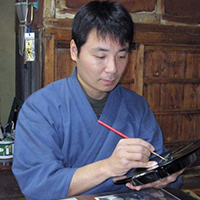Box of rantai with design in zonsei. “Sea and sky”
- Lacquerware
- Presented in 2015
- H 6.0 x W 28.5 x D 30.5 cm
- Contact for Price
| Category | Lacquerware |
|---|---|
| Year Presented | 2015 |
| Dimensions | H 6.0 x W 28.5 x D 30.5 cm |
| Exhibition | The 62nd Japan Traditional Kōgei Exhibition |
-
Lacquered bamboo
Bamboo is ideal for weaving various forms. The bamboo is split into thin strips, peeled, and coated with multiple layers of lacquer. Pieces of basketry made from lacquered bamboo (known as rantai) are lightweight and durable.
-
Zonsei
In zonsei lacquerwork, the outlines of colored motifs are engraved to produce additional decorative effects. Typically, one of two techniques is used. In the first, the artisan applies the motifs in colored lacquer before using a carving tool called a zonsei ken to incise the outlines of the design or add decorative line engravings. In the second, the artisan creates motifs using the kinma technique, which are then outlined or engraved in the same fashion. Zonsei, like carved lacquer (chōshitsu) and kinma, is a technique associated primarily with Takamatsu in Kagawa prefecture.
Takashi Tsuji

I was born and raised in a family of makie lacquerers; that is three generations from my great-grandfather. This is quite rare in Kagawa Prefecture, and naturally, I took up the path of urushi art in high school and junior college. My father was the most pleased with my progress, and after he died from an illness, I continued my studies under urushi artist OTA Hitoshi, and learned the technique of rantai kinma (incised and color-filled decoration on a woven bamboo core). While learning, I came to realize my life’s vocation is to create my own style, a fusion of my father’s colored maki-e and the master OTA’s rantai techniques.

